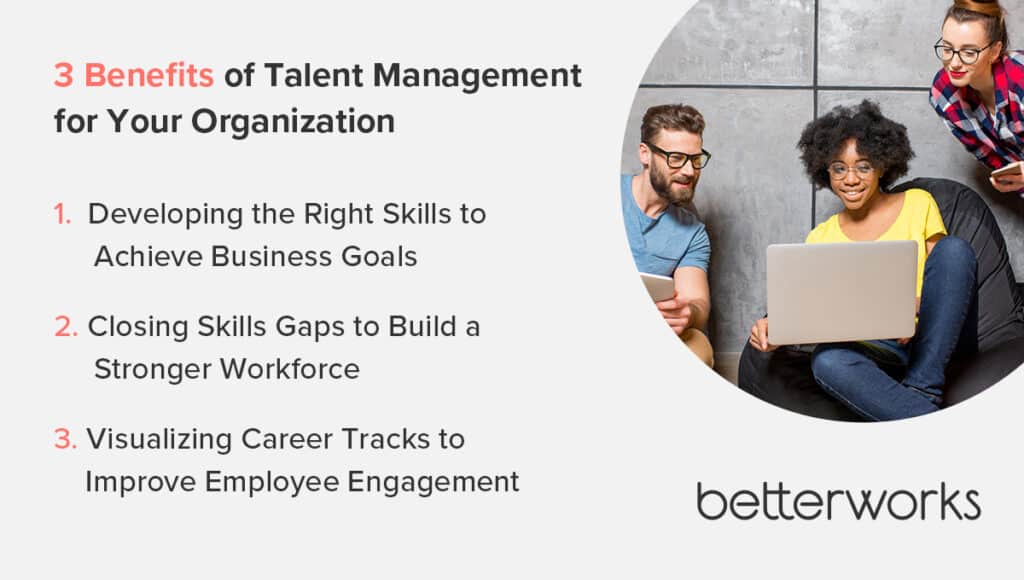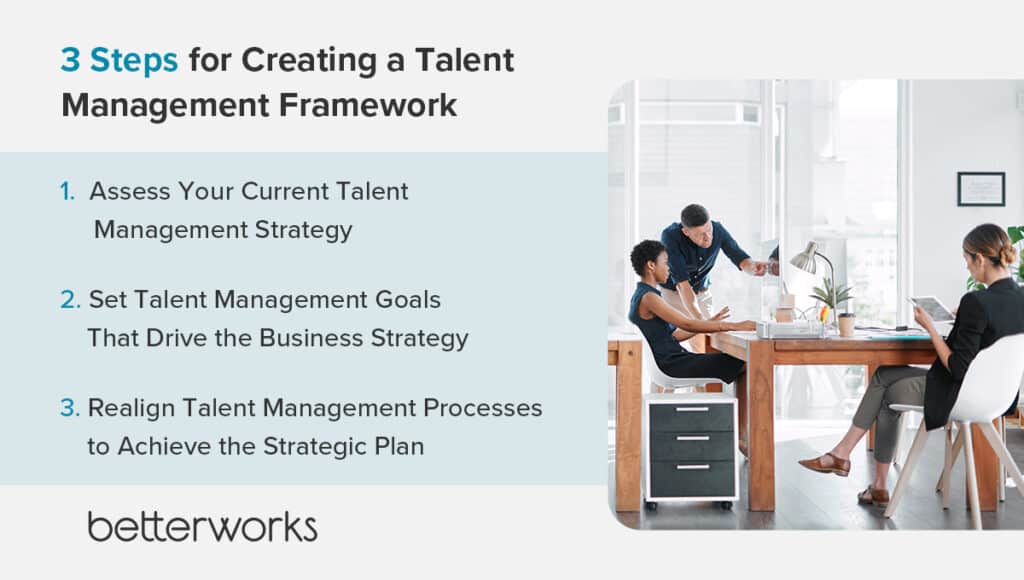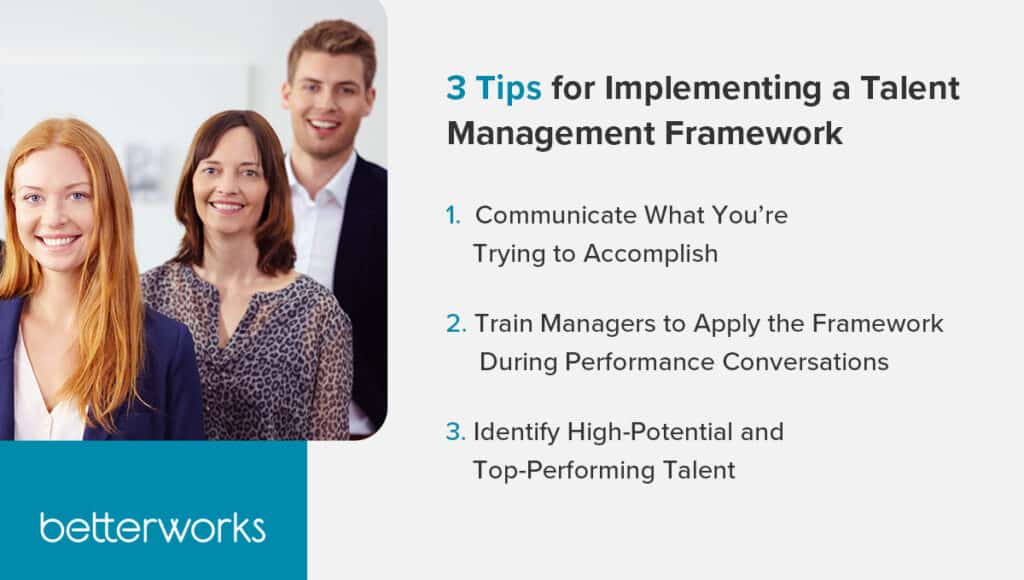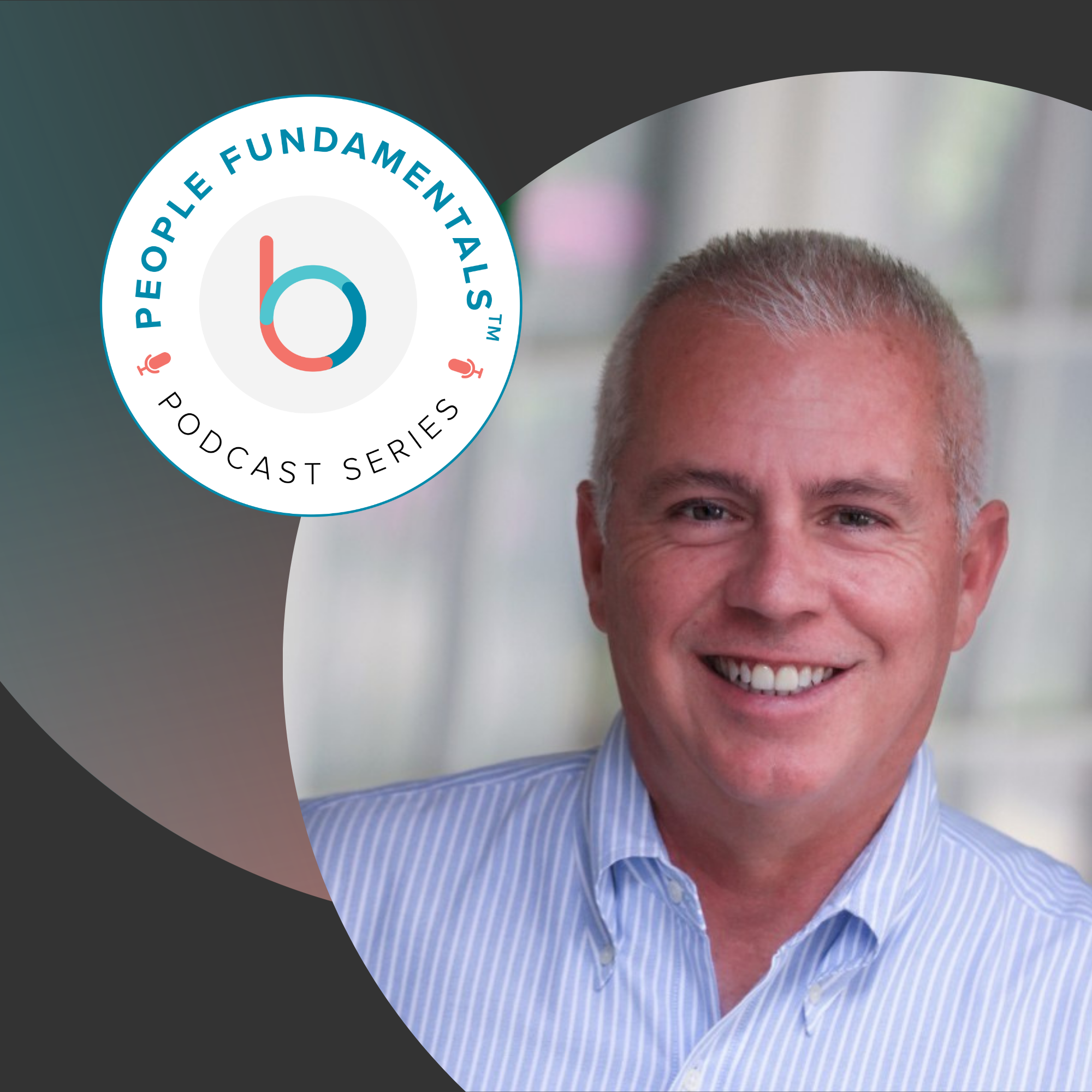- What is a talent management framework?
- Why does talent management matter for your organization?
- What is HR’s role in talent management and development?
- Best practices for creating a comprehensive and effective talent management framework
- 3 tips for implementing talent management framework
- Empower potential with a talent management framework
Keeping your workforce’s skills up to date and prepared to meet evolving business needs becomes overwhelming very quickly. To stay ahead of change, you need a structured approach to talent management and development — and that’s exactly what a talent management framework provides.
Talent management is the expression of your talent strategy through processes and outcomes. Your human resources team plays a crucial role in leading that strategy and execution through a thorough talent management framework.
Use our quick guide to learn what talent management frameworks are, why they’re an important part of your talent strategy, and how to implement them effectively.
What is a talent management framework?
A talent management framework is a system that organizations use to identify, develop, and retain employees with the necessary skills and abilities to meet current and future business needs. The ultimate goal of a talent management framework is to ensure that an organization has the right people in the right jobs, with the right skills and abilities, to achieve its strategic objectives.
By implementing a talent management framework, organizations can better identify the talent they have and the talent they need and better match the two during workforce and succession planning. Businesses can better understand and align employee career paths with company needs.
A talent development framework falls under the larger umbrella of talent management. It takes the talent management strategy down to the micro level, fitting individual employees into the overarching talent management framework.
Many different talent management frameworks are available, but they all share certain common elements, including:
- Clarity around the organization’s strategy and how the business needs to evolve
- A clear definition of the desired outcomes or results that talent management needs to achieve
- A clear understanding of the skills and abilities required to achieve desired outcomes or results
- Strong processes for assessing the current skills and abilities of employees and identifying gaps
- Strong processes for developing and implementing plans to close those gaps
- Robust systems for tracking progress and measuring results
An effective talent management framework provides direction and lays out a plan to help you attract, develop, and retain the talent your business needs to achieve its strategic goals.
Why does talent management matter for your organization?
Organizations today are under increasing pressure to do more with less. To stay competitive, you need to optimize your resources and your employees’ capabilities. Talent management is a strategic approach to identifying, developing, and retaining high-potential employees.
Achieving business goals requires the right skills in the right places
You’ll find the details about your company’s strategy, goals, and objectives in its business plan, which also dictates your talent needs. Using business priorities as a guide, identify the skills and competencies your organization needs to succeed.
Once you have identified the required skills, the organization needs to assess where those skills currently live within it.
If you find that gaps exist in the skills you need, you need to take steps to close them. Use talent management programs like training and development, recruiting, and succession planning to close skills gaps and prepare the workforce to achieve business goals.
Closing skills gaps builds a stronger workforce of top talent
You can improve employee productivity and build a more engaged workforce by closing skills gaps through sourcing talent or upskilling the talent you already have. Once you’ve identified the skills your organization needs to succeed, you can develop targeted recruiting and training programs to attract and retain top talent.
That manifests as individual development plans for each person in your workforce. A skills development plan helps employees know what you expect and what they need to work on. Regularly tracking progress against the skills development plan ensures that employees make progress and that the plan is effective.
Visualizing career tracks supports long-term employee engagement
Organizations that provide their employees with clear career tracks and opportunities for internal mobility retain them for the long term. Employees need to know their options for internal mobility, including lateral moves.
Lateral moves can be just as important as promotions for driving employee engagement. They provide employees with new challenges and let them develop new skills. Encourage employees to explore lateral moves and provide support to help them transition into new parts of the business.
To help employees decide where they fit best, provide employees with a clear understanding of the expectations and skills required for each role.
Employees also need to know what learning opportunities are available to them so they can make informed decisions about their future. Equip managers with comprehensive knowledge of your learning programs. Match the learning outcomes of each program to specific skills, and align those with roles across the organization.

What is HR’s role in talent management and development?
HR’s role in talent management is to identify, attract, develop, and retain top talent. HR must first understand what “talent” means for the organization to do this effectively. HR professionals lead several programs that do just that. Explore some HR programs that fit into and support your larger talent management framework.
Workforce planning
Workforce planning is the strategic process of aligning an organization’s people resources with its business goals. The process involves identifying the skills and competencies in the workforce and those you will need in the future.
The first step is identifying the organization’s current and future workforce needs. This includes assessing the skills and knowledge required to perform the work and the number of employees needed.
Once you have identified current and future workforce needs, you can develop a plan to address gaps. This may include training and development initiatives and recruiting and hiring new employees. For instance, you may reassess your talent acquisition and recruitment processes to attract more global talent.
The third step is implementing the workforce plan, which includes setting up systems and processes to track progress and ensure that your organization executes the plan effectively.
The fourth and final step is to track and adjust the workforce plan as needed. Workforce planning is an ongoing process that HR should regularly review to ensure that the workforce remains aligned with the changing needs of the business. This step helps ensure that the plan remains responsive to the organization’s changing needs.
Succession planning
While workforce planning takes a broad view of talent management, succession planning takes a much narrower, more targeted scope. It starts with specific key roles and makes a proactive plan to fill them.
Take your cue from the workforce plan. Determine the key positions critical to achieving the organization’s desired future state.
What those positions are may change, so stay open to adapting your succession plan across the business’s life cycle. Right now, for example, you may just have a director of engineering. In the future, however, you may learn that the business needs you to expand that role into a chief information officer.
Once you’ve identified the most critical roles, plan to match high-potential employees to them and provide them with the necessary development opportunities. This helps ensure that a talent pipeline exists to fill critical positions as they become vacant.
Succession planning is also important from an employee engagement and retention perspective. By identifying high-potential employees and providing them with development opportunities, organizations can help retain these employees and prevent them from leaving for other organizations.
Performance management
Performance management plays a key role in your talent management framework, too. It’s your primary system for identifying potential high performers and finding opportunities to give them greater responsibilities. Performance conversations in the flow of work keep business priorities top of mind and help managers identify individuals who may need additional development to reach their full potential.
Performance management provides data you can use at the micro level to assess an employee’s abilities and at the macro level to assess workforce skills and capabilities. Fitting this data into your talent management framework lets you keep a close eye on skills gaps and provide direction for individual employee growth.
Training and development
Your training and development plan brings your talent management framework full circle, from the macro level (supporting workforce planning) to the micro level (supporting each team member’s career goals).
At the highest level, training and development help ensure that the workforce has the skills and knowledge necessary to perform effectively. It also helps keep employees up to date with changes in technology, methods, and procedures so you can anticipate and proactively close skills gaps as they emerge.
At the individual level, training and development help employees better prepare for promotions or new responsibilities, empowering greater internal mobility. A robust learning program helps people see what other roles are open, and taking a course enables them to “test drive” positions they may not encounter on their own.
Best practices for creating a comprehensive and effective talent management framework
There is no one-size-fits-all answer when creating a talent management system, as the best approach will vary depending on the organization’s specific needs. However, there are some best practices that all organizations should keep in mind when developing their talent management framework.
Assess your current talent management strategy
For this assessment, you’ll need to look at your business goals and objectives and identify the skills and experience required to achieve those goals.
Once you clearly understand your company’s talent needs, you can start assessing your current talent management strategy. Consider these questions:
- Are you recruiting candidates with the right skills and experience?
- Are your training and development programs effective?
- Do employees understand their options for internal mobility?
- Do you have the right tools and technology to support your talent management strategy?
As you address each of these questions, identify points in your current strategy where you can make small changes with a big impact. This will help you prioritize your resources when you’re ready to implement your plan.
Set talent management goals that drive the business strategy.
You’ll need to establish what business goals your talent management strategy should support. Then, you’ll want to develop specific talent management goals that align with and support the business goals.
For example, if the business goal is to increase market share, then a talent management goal could be to increase the number of top performers in the organization. It’s vital to ensure that the talent management goals are measurable so you can track progress and determine whether the strategy is successful. Key results for this goal might include higher productivity, greater efficiency, or higher quality of work.
Finally, you’ll need to communicate the talent management goals to all relevant stakeholders and get buy-in from them. Managers are a key stakeholder group because they execute your talent strategy on the frontlines by coaching employees, improving their performance, and helping them find their purpose within the organization.
Realign talent management processes to achieve the strategic plan
Aligning talent management processes with the organization’s business strategy enables you to invest your resources in ways that will drive the biggest impact. With a clear picture of your current processes and where the business wants to go, develop a plan to realign your processes to better support business goals.
If one of your goals is to improve a department or team’s quality of work, for example, you might implement additional training modules or continuing education credits in those areas. Or, you might train managers to hold employees more accountable for their work.

3 tips for implementing talent management framework
As you implement your talent management framework, there are a few key things to keep in mind to set up your organization for success.
Communicate what you’re trying to accomplish
Before implementing a talent management framework, you must communicate what you’re trying to accomplish with the framework to employees. Doing this will help ensure that employees are on board with the changes and are more likely to actively participate in its associated HR programs.
A talent management framework doesn’t just benefit the business; it also hits on two key employee priorities. One is the enhanced sense of purpose people gain when they see how their actions contribute to the bottom line. Another is the opportunity for growth and mobility within the organization, which helps people see all possible paths they could take in their careers.
Incorporate these ideas into your messaging around talent management process changes to inspire greater interest and effort in what you’re trying to do.
Train managers to apply the framework during performance conversations
Encourage managers to use your talent management framework to identify employee development needs and goals and to provide actionable, growth-oriented advice.
Make sure managers understand how to use your talent management framework to create action plans for employees. Train them on the skill sets required in different roles or job families and how to recognize those skills within their team by assessing behaviors and performance.
There’s more to consider than what people are good at, though. Employee purpose and interests are key to successfully implementing a talent management framework. During check-ins, managers help draw that out and guide team members to opportunities that reflect their skills and interests.
Identify high-potential and top-performing talent
Implement performance management or goal alignment software to help capture data points from manager check-ins with their teams. By assessing that data, you can discover important trends in individual employee performance that can drive your talent strategy forward. To identify high-potential, top-performing talent at a high level, consider employees’ potential as well as their past performance.
Potential can be challenging to measure, but you can do it in a few different ways, such as by using assessments or looking at a team member’s track record of learning new skills and taking on new challenges. Performance, on the other hand, is something you can easily measure through productivity metrics or goal completion records.
By taking both potential and performance into account, you’ll be able to more accurately identify which individuals have the most potential to take on key roles in your organization successfully.

Empower potential with a talent management framework
A talent management framework will help you foresee your business’s upcoming talent demands and give your employees the skills they need to stay ahead of the curve. It puts your talent strategy into practice and enables every team member to be an asset to your company for years to come.
Learn more about streamlining your workforce with talent management systems.






